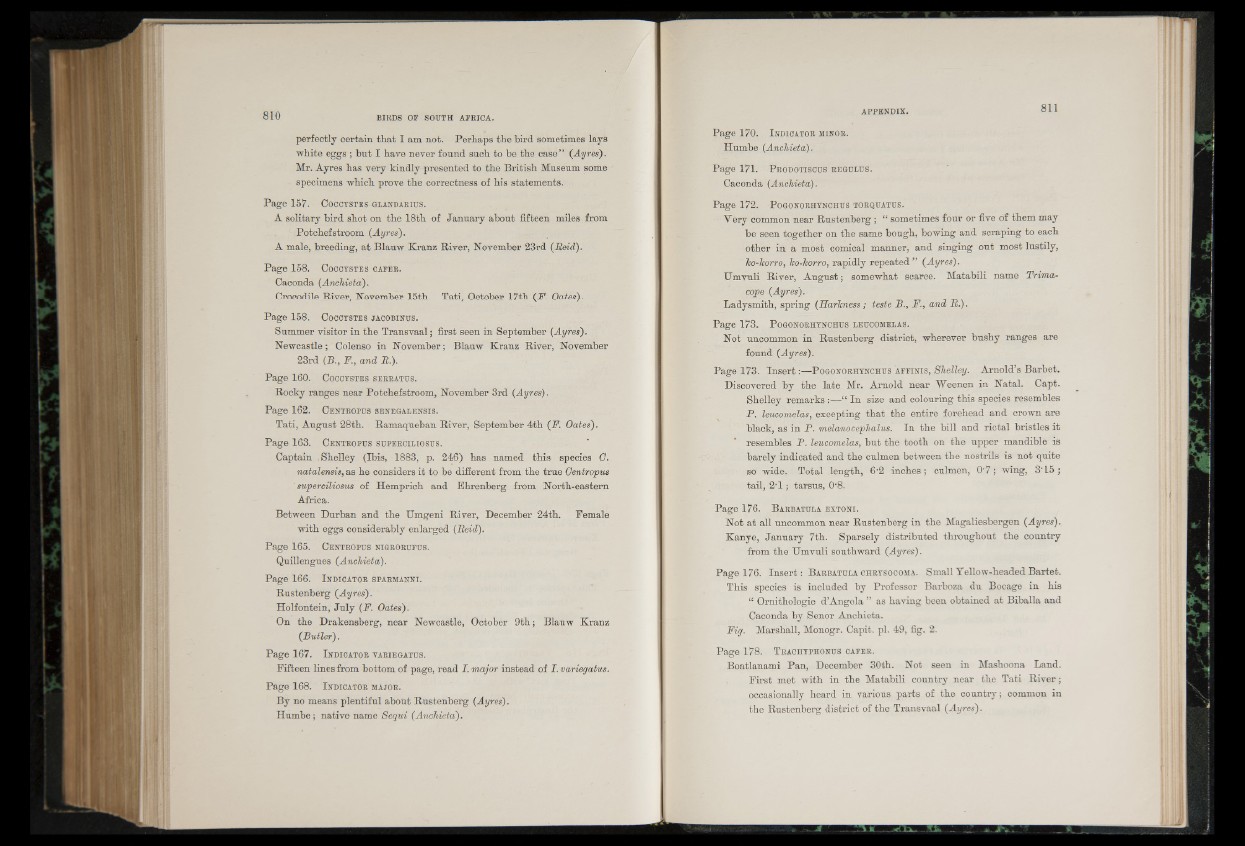
perfectly certain th a t I am not. Perhaps the bird sometimes lays
white eggs ; but I have never found such to be the case” {Ayres).
Mr. Ayres has very kindly presented to the British Museum some
specimens which prove the correctness of his statements.
P a g e 157. C o c c y s te s g l a n d a r iu s .
A solitary bird shot on the 18th of January about fifteen miles from
Potchefstroom (Ayres).
A male, breeding, a t Blauw Kranz River, November 23rd (Reid).
Page 158. C o c c y s te s c a p e r.
Caconda (Anchieta).
Crocodile River, November 15th. Tati, October 17th (F. Oates).
Page 158. C o c c y s te s ja c o b in u s .
Summer visitor in the Transvaal; first seen in September (Ayres).
Newcastle; Colenso in November; Blauw Kranz River, November
23rd (B., F., and R.).
Page 160. C o c c y s te s s e r r a t u s .
Rocky ranges near Potchefstroom, November 3rd (Ayres).
P a g e 162. C entropus senegalensis.
Tati, August 28th. Ramaqueban River, September 4th (F. Oates).
Page 163. C e n tr o p u s s u p e h c ilio s u s .
Captain .Shelley (Ibis, 1883, p. 246) has named this species G.
natalensis, as he considers it to be different from the true Centropus
' superciliosus of Hemprich and Ehrenberg from North-eastern
Africa.
Between Durban and the Umgeni River, December 24th. Eemale
with eggs considerably enlarged (Reid).
P a g e 165. C entropus nigrorupus.
Quillengues (Anchieta).
P a g e 166. I ndicator sparmanni.
Rustenberg (Ayres).
Holfontein, July (F. Oates).
On the Drakensberg, near Newcastle, October 9 th ; Blauw Kranz
(Butler).
P a g e 167. I ndicator variegatus.
Fifteen lines from bottom of page, read I. major instead of I. variegatus.
P a g e 1 68. I ndicator major.
By no means plentiful about Rustenberg (Ayres).
Humbe; native name Sequi (Anchieta).
Page 170. I n d i c a to r m in o r.
Humbe (Anchieta).
Page 171. P r o d o t i s c u s r e g u lu s .
Caconda (Anchieta).
Page 172. P o g o n o r h y n c h u s t o r q u a t u s .
Very common near Rustenberg ; “ sometimes four or five of them may
be seen together on the same bough, bowing and scraping to each
other in a most comical manner, and singing out most lustily,
ho-korro, ho-horro, rapidly repeated ” (Ayres).
TTmvuli River, A ugust; somewhat scarce. Matabili name Trima-
cope (Ayres).
Ladysmith, spring (SarJeness ; teste B., F., and R.).
Page 173. P o g o n o rh y n c h u s le u c om e la s .
Not uncommon in Rustenberg district, wherever bushy ranges are
found (Ayres).
Page 173. Insert S - P o g o n o r h y n c h u s a p f in is , Shelley. Arnold’s Barbet.
Discovered by the late Mr. Arnold near Weenen in Natal. Capt.
Shelley remarks In size and colouring this species resembles
P. leucomelas, excepting th a t the entire forehead and crown are
black, as in P . melanocephalus. In the bill and rictal bristles it
resembles P. leucomelas, but the tooth on the upper mandible is
barely indicated and the culmen between the nostrils is not quite
so wide. Total length, 6'2 inches; culmen, 0-7 ; wing, 3* 15 ;
tail, 2 '1 ; tarsus, 0‘8.
Page 176. B a r b a t u l a e x to n i.
Not a t all uncommon near Rustenberg in the Magaliesbergen (Ayres).
Kanye, January 7th. Sparsely distributed throughout the country
from the Umvuli southward (Ayres).
Page 176. In s e r t: B a r b a t u l a c h ry so c om a . Small Yellow-headed Bartet.
This species is included by Professor Barboza du Bocage in his
“ Ornithologie d’Angola ” as having been obtained at Biballa and
Caconda by Senor Anchieta.
Fig. Marshall, Monogr. Capit. pi. 49, fig. 2.
Page 178. T r a c h y p h o n u s c a p e r .
Boatlanami Pan, December 30th. Not seen in Mashoona Land.
First met with in the Matabili country near the Tati R iv e r;
occasionally heard in various parts of the country; common in
the Rustenberg district of the Transvaal (Ayres).